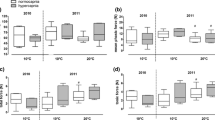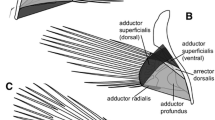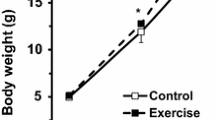Abstract
In scallops, mobilization of reserves from the adductor muscle to support maintenance and reproductive activity may impinge upon a major role of the adductor muscle, the movement of the valves during swimming and escape responses. The tropical scallop Euvola ziczac (Linnaeus 1758) invests energy reserves to different degrees during its two periods of reproduction each year. We evaluated the impact of reproductive investment on the escape responses (clapping capacity and recovery after exhaustive exercise) of E. ziczac sampled at different reproductive stages (immature, mature, spawned) during the two reproductive periods in 1997. We compared the escape response capacities with the levels of muscle energetic reserves (glycogen, proteins, and arginine phosphate) and muscle metabolic capacities [activity of the glycolytic enzymes: glycogen phosphorylase (GP), pyruvate kinase (PK), phosphofructokinase (PFK), octopine dehydrogenase (ODH), arginine kinase (AK), and the mitochondrial enzyme, citrate synthase (CS)]. Gonad size, gamete volume fraction, and levels of gonadal protein and lipid were greater for mature scallops during the first than during the second reproduction. Numbers of claps during escape responses (49–57) and levels of muscle arginine phosphate remained similar throughout the different reproductive stages in both reproductive periods. In contrast, recovery was slowed during gonadal maturation in both reproductive periods and during spawning in the first reproduction. Scallops generally took more time to regain their initial clapping capacity during the first (25–40 min) than during the second reproduction (20–30 min). Muscle glycogen decreased markedly during both gonadal maturation and spawning in both reproductions; whereas, muscle proteins decreased only in the first reproduction. The levels of most enzymes decreased during gonadal maturation in both reproductions, and also after spawning, particularly during the first reproduction. We concluded that gonadal maturation and spawning did not decrease clapping capacity of E. ziczac, but decreased its capacity to recover from exhaustive exercise most likely due to decreased levels of energetic reserves and a reduced metabolic capacity of the adductor muscle. Moreover, these effects were probably stronger during the first cycle because of the greater reproductive investment coincident with decreased food availability.
Similar content being viewed by others
Author information
Authors and Affiliations
Additional information
Received: 28 April 2000 / Accepted: 21 September 2000
Rights and permissions
About this article
Cite this article
Brokordt, K., Himmelman, J., Nusetti, O. et al. Reproductive investment reduces recuperation from exhaustive escape activity in the tropical scallop Euvola zizac. Marine Biology 137, 857–865 (2000). https://doi.org/10.1007/s002270000415
Issue Date:
DOI: https://doi.org/10.1007/s002270000415




